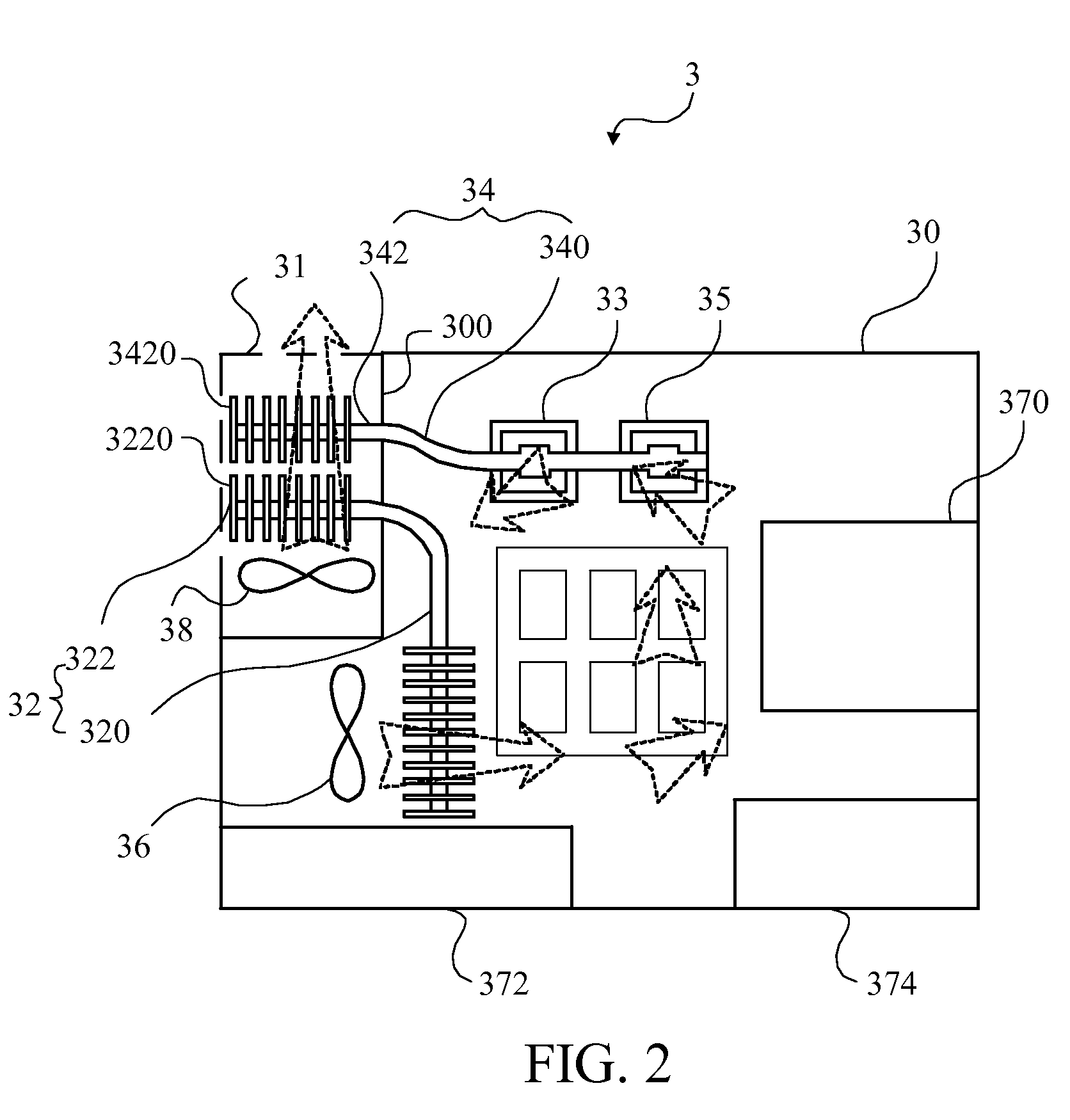Electronic apparatus
a technology of electronic equipment and electrical components, applied in the direction of electrical equipment casings/cabinets/drawers, instruments, cooling/ventilation/heating modifications, etc., can solve the problems of poor heat dissipation, poor heat dissipation, and the inside of the housing can even have no ventilation holes, so as to achieve more effective heat exchange mechanisms, enhance heat exchange efficiency, and thermal convection
- Summary
- Abstract
- Description
- Claims
- Application Information
AI Technical Summary
Benefits of technology
Problems solved by technology
Method used
Image
Examples
first embodiment
[0023]Please refer to FIG. 2, FIG. 2 shows a scheme diagram of an industrial computer 3 in the invention. As shown in FIG. 2, the industrial computer 3 includes a sealed housing 30, a first heat-conducting component 32, a second heat-conducting component 34, and a first fan 36. The first fan 36 is mainly used to improve the inner thermal convection efficiency of the sealed housing 30 to bring the heat generated from the electronic components with smaller heating amount via air convection, and the first heat-conducting component 32 further conducts the heat of the inner air-flow to the outside of the sealed housing 30. The second heat-conducting component 34 is mainly used to enhance the thermal conduction efficiency of the electronic components with larger heating amount, so that most of the heat can be conducted to the outside of the sealed housing 30 via the thermal conduction effect.
[0024]As shown in FIG. 2, the first fan 36 is disposed in the sealed housing 30, and the first hea...
second embodiment
[0032]Besides the above-mentioned types, the industrial computer of the invention can still have other types, as shown in FIG. 3 and FIG. 4. Please refer to FIG. 3, FIG. 3 shows a scheme diagram of the industrial computer 5 in the invention. Compared to FIG. 2, a first fan 56 of the industrial computer 5 shown in FIG. 3 is near a CD-ROM drive 570 instead of a first heat-conducting part 520. Of course, the first fan 56 can be also disposed near other electronic components (e.g., a hard disk 572 and a power supply 574). Compared to FIG. 1, the disposition of the first fan 56 in FIG. 3 can increase the mobility of the air near the electronic components without covering any heat-conducting component. Of course, there is no conflict between the disposition of the first fan 56 in FIG. 3 and the disposition of the first fan 36 in FIG. 2, the first fan 56 and the first fan 36 can be disposed at the same time to enhance the heat convection effect.
third embodiment
[0033]Please refer to FIG. 4, FIG. 4 shows a scheme diagram of an industrial computer 7 in the invention. Compared to FIG. 2 and FIG. 3, the first heat-conducting component 72 of the industrial computer 7 shown in FIG. 4 includes several fins instead of a heat pipe. The fins are extended inward and outward from a side surface 700 of the housing 70, therefore, a first fan 76 and a second fan 78 drive air-flows flowing toward the fins to process the heat-conducting and heat-dissipating effect.
[0034]Besides the above-mentioned mechanical design (fans and heat-conducting components), a temperature sensor can be set on the mechanism of the industrial computer, and a temperature control circuit can be added into the circuit of the industrial computer. In this way, the first fan and the second fan can start or change their rotating speed according to different temperature conditions. For example, when the temperature in the sealed housing is lower, the first fan and the second fan can shut...
PUM
 Login to View More
Login to View More Abstract
Description
Claims
Application Information
 Login to View More
Login to View More - R&D
- Intellectual Property
- Life Sciences
- Materials
- Tech Scout
- Unparalleled Data Quality
- Higher Quality Content
- 60% Fewer Hallucinations
Browse by: Latest US Patents, China's latest patents, Technical Efficacy Thesaurus, Application Domain, Technology Topic, Popular Technical Reports.
© 2025 PatSnap. All rights reserved.Legal|Privacy policy|Modern Slavery Act Transparency Statement|Sitemap|About US| Contact US: help@patsnap.com



